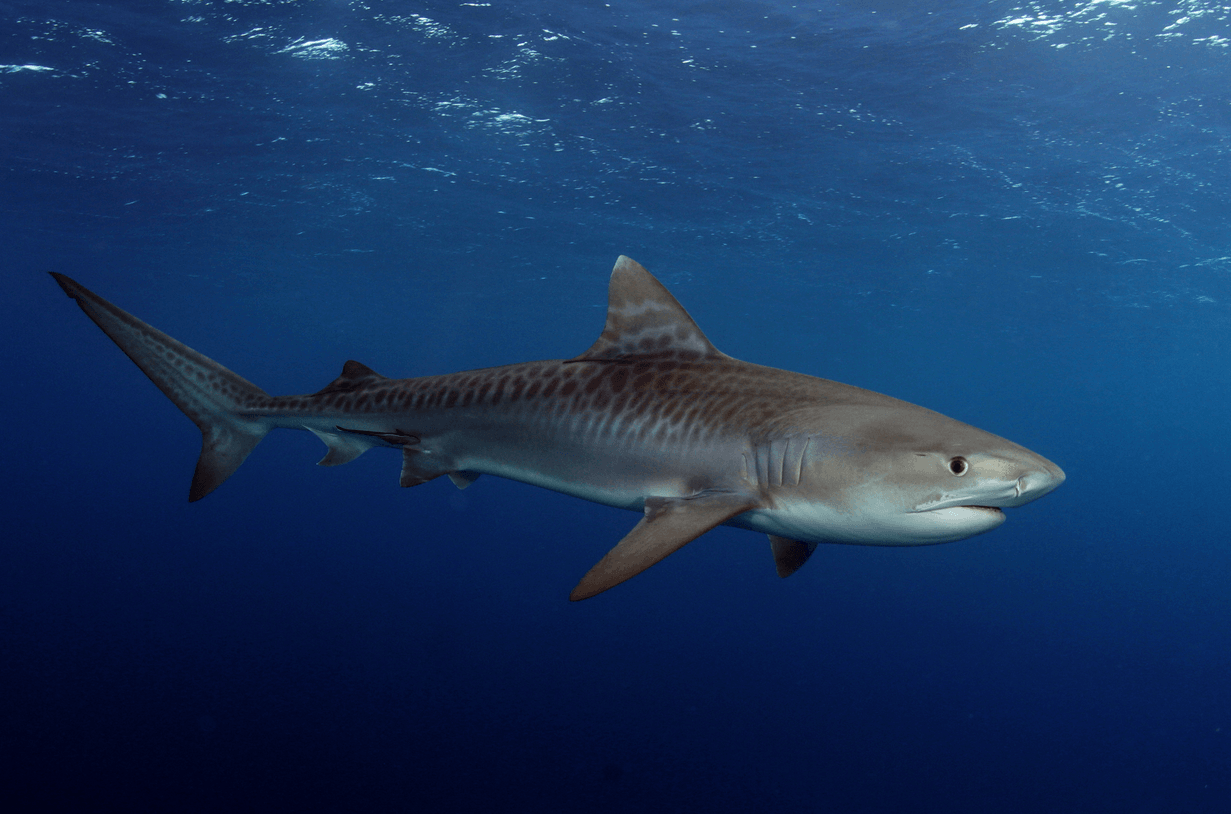
Introduction
The tiger shark, also known as Galeocerdo cuvier, is a large predatory shark that is commonly found in tropical and subtropical waters around the world. It is known for its distinctive pattern of dark vertical stripes on its body, which resemble a tiger's pattern, hence its name. With its unique appearance and fascinating behavior, the tiger shark has become a subject of interest for many marine enthusiasts and researchers.

Physical Characteristics
The tiger shark is one of the largest shark species, with adult females typically reaching lengths of around 12-15 feet. However, some individuals have been known to grow even larger, with reports of specimens measuring up to 18 feet. They can weigh anywhere between 850 to 1,400 pounds, depending on their size and age. The shark's body is robust and cylindrical, tapering towards the tail.

Distinctive Features
One of the most distinctive features of the tiger shark is its mouth, which is large and equipped with powerful jaws and sharp, serrated teeth. Their teeth are uniquely shaped, with a broad, triangular main cusp and smaller cusplets on either side. This dental arrangement allows them to efficiently grasp and tear apart their prey.
Another notable feature of the tiger shark is its skin, which is thick and covered in dermal denticles. These denticles provide protection against abrasions and parasites, as well as reduce drag as the shark swims through the water.

Habitat and Distribution
Tiger sharks are highly adaptable and can be found in a variety of habitats, including coastal waters, coral reefs, and even open ocean areas. They have a wide distribution and can be found in tropical and subtropical waters around the world, with sightings reported in the Pacific, Atlantic, and Indian Oceans.
These sharks are known to be opportunistic feeders and are often found near areas with abundant food sources, such as estuaries, river mouths, and offshore reefs. They have been observed to migrate long distances in search of food, following prey migrations and taking advantage of seasonal feeding opportunities.

Diet and Feeding Behavior
Tiger sharks are known for their voracious appetite and wide-ranging diet. They are often referred to as "garbage cans of the sea" due to their ability to consume a wide variety of prey items. Their diet includes fish, sea turtles, seals, dolphins, seabirds, and even other sharks. They are also known to scavenge on carcasses and consume marine debris.
Tiger sharks have a unique hunting strategy that involves using their powerful sense of smell and excellent vision to locate potential prey. They are known to investigate and sample objects in their environment, often biting them to determine if they are edible. This behavior has led to encounters with humans and incidents of "bite and release" attacks.

Reproduction and Life Cycle
Tiger sharks are ovoviviparous, meaning that the embryos develop inside eggs within the mother's body until they hatch. After a gestation period of around 14-16 months, the female gives birth to live young, typically ranging from 10 to 80 pups. The newborn tiger sharks measure around 20-30 inches in length.
It is worth noting that tiger sharks have one of the lowest reproductive rates among sharks, with females only giving birth every few years. This, coupled with their slow growth rate and late maturation, makes the species vulnerable to overfishing and population decline.

Conservation Status
The tiger shark is currently listed as a near-threatened species by the International Union for Conservation of Nature (IUCN). They face numerous threats, including overfishing, habitat degradation, and accidental capture in fishing gear. Their slow reproductive rate and late maturation make them particularly vulnerable to population decline.
Efforts are being made to protect tiger sharks through the establishment of marine protected areas and the implementation of fishing regulations. Additionally, raising awareness about the importance of these apex predators in maintaining the balance of marine ecosystems is crucial for their conservation.
Conclusion
The tiger shark is a captivating and powerful predator that plays a crucial role in marine ecosystems. With its distinctive appearance and wide-ranging diet, it has earned its place as one of the most fascinating shark species. However, it is important to remember the importance of conservation efforts to ensure the long-term survival of these majestic creatures.